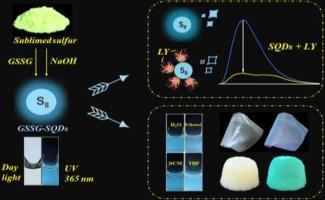Emissive glutathione modified sulphur quantum dots for the sensing of lemon yellow and luminescent hydrogels/films
IF 4.3
2区 化学
Q1 SPECTROSCOPY
Spectrochimica Acta Part A: Molecular and Biomolecular Spectroscopy
Pub Date : 2024-11-05
DOI:10.1016/j.saa.2024.125401
引用次数: 0
Abstract
Lemon yellow (LY) is an azo dye which is widely used as food colorant. The continuous consumption can result in the safety concerns for both human and environmental health. This study describes a new sulphur quantum dot (SQD) based fluorescent sensor, which was facilely prepared with oxidized-glutathione (GSSG) as passivator at mild condition of 75 °C. The obtained sulphur quantum dots (GSSG-SQDs) have a relative quantum yield of 0.25, which is 2–5 times that of most SQDs. GSSG-SQDs were used as a sensor for lemon yellow in the concentration range of 0.10–70 μM and the limit of detection of 60 nM. The application was verified with the real sensing of lemon yellow in the soft drinking and tap water, having the standard recovery from 92.5 % to 105 %. Given the great luminescence and photostability, GSSG-SQDs were used as a filler for the preparation of luminescent films and hydrogels as a promising material for a wide range of applications such as information encryption and bioengineering.

用于感测柠檬黄和发光水凝胶/薄膜的发光谷胱甘肽修饰硫量子点。
柠檬黄(LY)是一种偶氮染料,被广泛用作食品着色剂。持续食用会对人类和环境健康造成安全隐患。本研究介绍了一种基于硫量子点(SQD)的新型荧光传感器,该传感器以氧化谷胱甘肽(GSSG)为钝化剂,在 75 °C 的温和条件下轻松制备。获得的硫量子点(GSSG-SQDs)的相对量子产率为 0.25,是大多数 SQDs 的 2-5 倍。GSSG-SQDs 被用作柠檬黄的传感器,浓度范围为 0.10-70 μM,检测限为 60 nM。通过实际检测软饮料和自来水中的柠檬黄,验证了这一应用,其标准回收率为 92.5 % 至 105 %。鉴于 GSSG-SQDs 具有很强的发光和光稳定性,它被用作制备发光薄膜和水凝胶的填充物,是一种很有前途的材料,可广泛应用于信息加密和生物工程等领域。
本文章由计算机程序翻译,如有差异,请以英文原文为准。
求助全文
约1分钟内获得全文
求助全文
来源期刊
CiteScore
8.40
自引率
11.40%
发文量
1364
审稿时长
40 days
期刊介绍:
Spectrochimica Acta, Part A: Molecular and Biomolecular Spectroscopy (SAA) is an interdisciplinary journal which spans from basic to applied aspects of optical spectroscopy in chemistry, medicine, biology, and materials science.
The journal publishes original scientific papers that feature high-quality spectroscopic data and analysis. From the broad range of optical spectroscopies, the emphasis is on electronic, vibrational or rotational spectra of molecules, rather than on spectroscopy based on magnetic moments.
Criteria for publication in SAA are novelty, uniqueness, and outstanding quality. Routine applications of spectroscopic techniques and computational methods are not appropriate.
Topics of particular interest of Spectrochimica Acta Part A include, but are not limited to:
Spectroscopy and dynamics of bioanalytical, biomedical, environmental, and atmospheric sciences,
Novel experimental techniques or instrumentation for molecular spectroscopy,
Novel theoretical and computational methods,
Novel applications in photochemistry and photobiology,
Novel interpretational approaches as well as advances in data analysis based on electronic or vibrational spectroscopy.

 求助内容:
求助内容: 应助结果提醒方式:
应助结果提醒方式:


